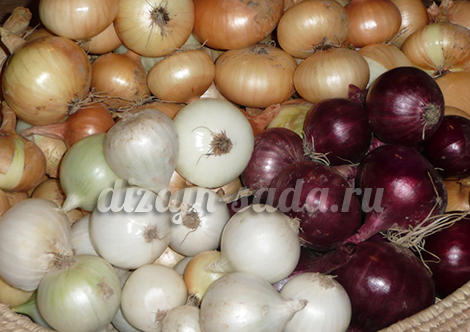Content
- 1 Apricot
- 2 Indian summer
- 3 Bryansk jubilee
- 4 Hercules
- 5 Eurasia
- 6 Yellow giant
- 7 Golden domes
- 8 Polka
- 9 Ruby necklace
- 10 Elegant
- 11 The best remontant varieties of raspberries
- 12 The best classic raspberries
- 13 The best standard raspberry varieties
- 14 Benefits of remontant varieties of raspberries
- 15 Indian summer
- 16 Bryansk marvel
- 17 Brusvyan
- 18 Hercules
- 19 Eurasia
- 20 Golden domes
- 21 Zyugana (Shugana)
- 22 Orange miracle
- 23 Penguin
- 24 Bow to Kazakov
- 25 Polana
- 26 A shelf
- 27 Ruby necklace
- 28 Heritage
- 29 The best varieties of remontant raspberries, photo gallery
- 30 And what are we going to plant?
- 31 Caring for remontant raspberries, some features
- 32 Reviews of gardeners who can help determine the choice of variety
Repaired raspberry varieties are gradually gaining popularity among domestic gardeners. They are distinguished by unpretentiousness, high productivity and resistance to diseases. We have selected varieties that have held the title of the best of the best for several years.
One of the most popular garden berries is raspberry. In the CIS, traditional varieties are still preferred, although, for example, in Europe, Canada and the USA, up to 90% of plantings are remontant varieties. Their main difference is that they begin to bear fruit in the first year and allow you to harvest a bountiful harvest twice a season - in summer and autumn. Since most of the remontant raspberries come from warmer countries, in the middle lane, before the onset of cold weather, the berry simply does not have time to fully ripen. Recently, however, Russian breeders have bred varieties with a short growing season specifically for the northern regions. We managed to select the best varieties of both foreign and local origin.
Apricot
This is one of the most exotic varieties of raspberries. Although the bushes grow small, they nevertheless need a garter. The berries ripen on them are medium-sized and neat, yellow in color with a pinkish tinge, they are easily separated from the fruit. The shape of the raspberry is blunt-conical, the taste of the berries is reminiscent of apricot. The plant is practically resistant to diseases and pests. Connoisseurs especially recommend making jam of bright amber color from this raspberry.
| Appointment | Productivity (kg per bush) | Berry weight (g) | Bush height (m) | Maturation (period) | |
|
2,5-3,5 |
3-4 |
1,3-1,5 |
Early August - late October |
||
Indian summer
This is the first remontant raspberry variety bred in Russia. Designed for cultivation in the southern and central regions. The bush is sprawling, rather tall and erect. Berries of medium size, round-conical or spherical in shape. With the onset of ripeness, they acquire a dark crimson color. The taste is sweet and sour, but without a pronounced aroma. The pulp is tender and juicy, no frills. The variety is distinguished by winter hardiness, sometimes the plant is attacked by spider mites, powdery mildew disease and purple spot.
| Appointment | Productivity (kg per bush) | Berry weight (g) | Bush height (m) | Maturation (period) | |
|
1-2 |
3-4 |
1,8-2 |
Early June - early July. Early September - mid October |
||
Bryansk jubilee
A repaired early fruiting variety. The bushes are compact, with weak branching. The berries are not very large, beautifully elongated, bright red, sweet and sour.Under suitable conditions, fruiting begins in late July and then resumes in the fall. Productivity and, importantly, crop safety are at a high level. Disease resistance is average, the plant requires regular care, timely watering and feeding.
| Appointment | Productivity (kg per bush) | Berry weight (g) | Bush height (m) | Maturation (period) | |
|
2-3 |
3-4 |
1,2-1,4 |
Mid July - mid September |
||
Hercules
"Bryansk Bogatyr" is perfectly adapted to the climatic conditions of the middle zone. This variety is suitable for both domestic and industrial cultivation. The second wave of fruiting occurs closer to autumn, when the pests are no longer so active. Berries of intense ruby color with dense juicy pulp are similar to a truncated cone. Their taste is pleasant, sweet and sour. The variety is resistant to most fungal diseases, including gray mold. For the winter, it is advisable to cover the bush so that it does not freeze.
| Appointment | Productivity (kg per bush) | Berry weight (g) | Bush height (m) | Maturation (period) | |
|
2,5-3,5 |
5-7 |
1,5-2 |
Mid June. Mid August - early October |
||
Eurasia
A large-fruited variety, belongs to the standard varieties and at the same time is absolutely not picky about the composition of the soil and climate. An upright bush reaches a height of 1.5-1.6 m, so it is very convenient to pick berries from it. They are dark ruby in color, conical in shape, can be stored for quite a long time without loss of marketability. Raspberries taste sweet, but not sugary, but with a slight sourness and traditional raspberry aroma. The plant is quite resistant to all sorts of misfortunes, including temperature changes and pest activity.
| Appointment | Productivity (kg per bush) | Berry weight (g) | Bush height (m) | Maturation (period) | |
|
2-3 |
3,5-4,5 |
1,5-1,6 |
August - mid September |
||
Yellow giant
This type of raspberry is sometimes called the best variety for the middle lane. The bush has decorative properties, blooms very beautifully and bears fruit, so this raspberry in itself is a decoration of the garden. Neat yellow berries are useful for people with weakened immunity, allergy sufferers and pregnant women. They do not crumble from the bush for a long time and are perfectly stored. The plant has high frost resistance and is practically not afraid of various diseases.
| Appointment | Productivity (kg per bush) | Berry weight (g) | Bush height (m) | Maturation (period) | |
|
4-6 |
5-8 |
1,7-2 |
Mid July - mid October |
||
Golden domes
High-yielding variety of Russian selection. The bush is medium-sized, spreading, consists of 5-6 drooping shoots with small thorns. The berries are rather large, round-conical in shape and bright yellow in color, which later changes to apricot. The pulp is juicy, sweetish dessert, with an almost imperceptible raspberry aroma. The plant is resistant to the vast majority of diseases and is almost not attacked by pests. For the winter, it is advisable to leave only the rhizome, removing the entire aerial part.
| Appointment | Productivity (kg per bush) | Berry weight (g) | Bush height (m) | Maturation (period) | |
|
2-4 |
5-6 |
1,3-1,5 |
End of June - beginning of July. August - mid-October |
||
Polka
This is one of the most popular European varieties, the leader in yield among remontant raspberries. The bushes are practically devoid of thorns, so you can eat fresh raspberries without fear of scratching your hands. By the way, berries are the main advantage of this variety. They are beautiful, large, shaped like a thimble. The berries taste sweet, but not sugary; they are considered the standard of dessert taste. The plant is practically not susceptible to any type of disease. But what is contraindicated for bushes is heat and severe frost.
| Appointment | Productivity (kg per bush) | Berry weight (g) | Bush height (m) | Maturation (period) | |
|
2-3,5 |
5-6 |
1,5-1,8 |
End of July - beginning of October |
||
Ruby necklace
A high-yielding, transportable variety that is also suitable for industrial production. The bush is medium-sized, slightly spreading, with a small number of shoots.The berries are elongated, regular cylindrical, bright ruby color with a delicate sweet and sour pulp. At the end of fruiting, it is best to cut the aboveground part to ground level to avoid freezing of the plant.
| Appointment | Productivity (kg per bush) | Berry weight (g) | Bush height (m) | Maturation (period) | |
|
2-3 |
4-5 |
1,3-1,5 |
Mid August - mid October |
||
Elegant
This exquisite variety is appreciated by all lovers of a stable and abundant harvest. It is recommended for cultivation throughout Russia. A powerful bush is not prone to lodging, it grows no higher than human height. The berries are shiny, in the form of a wide obtuse cone, sometimes weighing up to 8 g. The taste is pleasant, the juicy pulp is sweet and sour. The plant practically does not get sick, the crop retains its presentation for a long time and is suitable for transportation over long distances.
| Appointment | Productivity (kg per bush) | Berry weight (g) | Bush height (m) | Maturation (period) | |
|
2,3-2,7 |
4-6 |
1,6-1,8 |
Early August - late September |
||
Repaired raspberry varieties are a real find for summer residents. These plants begin to bear fruit already in the first year, require minimal care, are slightly susceptible to diseases and pests, and at the same time yield up to 2 times a year. Try to plant at least one bush of remontant raspberries and you will not be disappointed.
Review of the best varieties of the sweetest raspberries according to gardeners' reviews
Raspberries are a popular and healthy summer berry. Old adapted varieties in Central Russia are distinguished by their unpretentiousness and vitality. On the site, raspberries can even behave aggressively, seizing new territories and expanding the boundaries of the raspberry. This behavior is due to the characteristics of the varieties and lack of care. The best varieties of raspberries according to reviews of gardeners from different regions are presented in our rating.
Raspberry varieties are conventionally divided into 4 groups: large-fruited, classic, renovation and standard (tree-like).
Large-fruited raspberry inherited from the parental forms a high mass of berries and low winter hardiness. When growing large-fruited varieties of raspberries in the Middle Lane, the shoots are bent down and covered for the winter. To obtain large berries, you will need to create the appropriate conditions: the introduction of organic matter, top dressing, prevention of diseases and pests, regular watering. On poor soils, you cannot get a good harvest, and in a drought the berries will simply dry out on the branches. The brightest representative of the group, which has many fans and is grown even in the Urals - Krasa Rossii.
Stock raspberrydespite the growing interest in the group, it remains exotic in Russian gardens. These varieties of raspberries are decorative, easy to pick berries, disease resistance and high yield (due to active lateral branching). "Raspberry tree" does not need support, the crown retains its shape under the weight of the berries. At the same time, the varieties show good frost resistance and unpretentious care. Formation consists in pinching the tops of the shoots by 10 - 15 cm. In this group, the Tarusa variety is distinguished.
Classic raspberry varieties bear fruit on the shoots of last year, so the ripening of berries begins early: from the end of June to July. Bushes overwinter with long shoots, which are recommended to be covered in the conditions of the Moscow region.
Repair raspberry bears fruit on both last year's and young shoots. But experienced gardeners recommend cutting out all the shoots in the winter and getting one late harvest on a young growth. In this case, the yield will be higher and the size of the berries will be larger. Fruiting period for remontant varieties: from late July to September-October. Many varieties of remontant raspberries are well suited for the Moscow region. Their advantages: they winter without problems, do not suffer from pests, and are superior in yield.
The choice of the best raspberry variety also depends on the purpose of the raspberry planting: for home use of dessert berries or for the sale of a marketable crop.Commercial varieties are distinguished by high yields, transportability and attractiveness of berries, but inferior in taste.
The best varieties of raspberries according to gardeners' reviews
The best remontant varieties of raspberries
|
Polka 250 (for one year old seedling in a bag with wet moss) A remontant dessert variety of Polish selection. Sprawling bush, 1.6 - 1.8 m high, forms little root growth, gives up to 10 replacement shoots. Shoots are strong, do not bend during fruiting, covered with small, thornless thorns. The berries are dark red, rounded-oblong, with an average weight of 5-6 g, sweet taste, with a pronounced bright aroma, well stored and transported. The yield of one bush, with proper care, exceeds 4 kg. Berries do not crumble, are transported, due to dry separation, they are ideal in freezing. Shows high resistance to gray rot and spider mites, but susceptible to cancer of the measles system. It has low winter hardiness, but with complete mowing of shoots, this disadvantage is not of paramount importance. In arid climates, it behaves badly. This remontant variety of raspberries received good reviews from gardeners in the Rostov region and the Moscow region. Main pluses:
Minuses:
|
 9.8 / 10 Rating Reviews The most delicious remontant berry. In regions with harsh winters, it is best to cut flush with the ground and mulch well.
|
|
Bryansk marvel 270 (for one year old seedling in a bag with wet moss) Repaired raspberry variety for commercial purposes and personal use. It is late in terms of ripening. The bush is 1.5 - 1.9 m high, slightly spreading, the formation of overgrowth is medium. The main shoots are thick with sparse soft thorns; there are no thorns on the fruit branches. The garter is done only in windy areas. Also, due to the long side shoots, the garter contributes to better ventilation and illumination of the lower tier. Berries of classic red color, cylindrical, elongated, up to 3 - 4 cm long, weighing from 5 - 7 to 11 - 20 g. Average yield - 3 kg per bush. The taste is sweet with sourness. The palatability rating is good and excellent. The berries are dense, store well and tolerate transportation. In order for the bush to realize its potential yield, the lower buds are removed, accelerating the ripening of the upper ones and promoting the formation of larger berries. It prefers light fertile soils; on heavy loams, the yield is sharply reduced. Average winter hardiness. In winter, it is recommended to mow the shoots to the ground, since the stump left takes away strength from the rhizome and reduces winter hardiness. The variety does not perform well in arid regions. Recommended for the Moscow region and the Central strip. Main pluses:
Minuses:
|
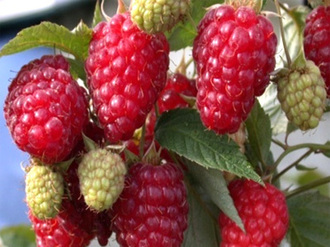 9.7 / 10 Rating Reviews This variety of raspberries fell in love with the late ripening, when only apples were left in the garden. With good care and proper fit, there are no problems with it.
|
|
Orange miracle 250 (for one year old seedling in a bag with wet moss) Repaired variety with orange berries. The bush is medium-sized, up to 1.7 m high, compact. Shoots are erect, heavily spiked, fragile and can break off under the weight of the berries. The formation of fruit branches is active and covers 2/3 of the length of the shoot. The bush forms up to 7 replacement shoots and gives a lot of growth. The berries are cone-shaped, with a slightly pointed apex, dense, even, up to 4 cm long and weighing 6 - 12 g. They have a delicate aroma and sweet taste with a slight sourness. The sugar content depends on the soil and climatic conditions of cultivation and the level of agricultural technology. The berries are well transported; when overripe, they remain on the branches. The yield from one bush reaches 3 kg, while before frost the variety manages to give 70 - 100% of the potential yield. There is a high resistance to pests and an average - to diseases. Dessert berry flavor and good transportability make the variety versatile. The variety has shown itself well in the Moscow and Rostov regions, it is recommended for the Central strip, the Urals and Western Siberia. When grown in an annual culture (cutting on a stump in winter), there is no risk of freezing of the shoots. Main pluses:
Minuses:
|
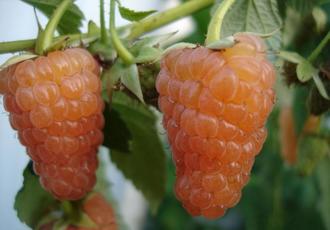 9.7 / 10 Rating Reviews The best sort of remontant raspberry for the Moscow region, in my opinion. The berry is delicious and very beautiful, ripens quickly. If you cut off the unripe berries along with the stalk, then they ripen perfectly.
|
|
Hercules 450 (for a 2 year old seedling in a container) Repaired grade for commercial purposes. The bush is 1.6 - 1.8 m high. The shoots are erect, with rigid thorns along the entire length, strong and do not require support. Lateral branching is abundant, shoots are weak (up to 3 - 4 replacement shoots). The variety tolerates thickened plantings well, does not require frequent thinning. Ruby berries, in the shape of a truncated cone, dense, weighing from 6 - 10 to 15 g, with a pronounced aroma. The taste is sweet and sour, refreshing, but in cold weather the sourness is more pronounced. The yield from one bush reaches 4 kg. Differs in high resistance to diseases (including viral) and pests, drought-resistant and winter-hardy. Waterlogging spoils the taste of the berry, making it watery. With a lack of heat and lighting during the ripening period, the berries turn out to be sour, they are good in compotes and jam. This variety of raspberries has adapted well in the Moscow region, the Middle Belt and the Urals, showing stability and unpretentiousness. In regions with cold rains in the second half of summer, it is impossible to get a high-quality berry without additional measures. Main pluses:
Minuses:
|
 9.5 / 10 Rating Reviews For beginners, this raspberry is the easiest to care for in comparison with other remontant varieties, top dressing and a well-chosen site, it is possible to get delicious berries.
|
|
Firebird 220 (for one year old seedling in a bag with wet moss) Repaired grade for small areas. Gardeners appreciate it for its excellent taste. In terms of yield, transportability and size it loses to other commercial varieties. More often grown for personal use. The bushes are compact, up to 2 m high, forming 5 - 8 replacement shoots. Shoots are covered with soft and thin thorns, to a lesser extent on the upper part. A garter to the trellis is required. Bright red berries of a conical shape with a blunt apex, glossy, drupes are large, dense, weighing 4 - 6 g. The yield per bush is 2 - 2.5 kg. Ripe berry does not crumble. If the berries are picked regularly, avoiding overripening, then the harvest is well transported. This raspberry shows good results in the southern regions, but due to insufficient heat resistance it needs mulching and shading. In the northern regions, it manages to realize only 70% of the potential yield. Main pluses:
Minuses:
|
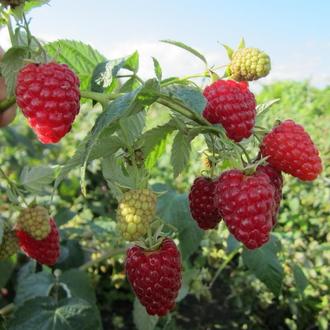 9.5 / 10 Rating Reviews An excellent dessert berry, it does not prick strongly, so the collection of berries is without negative. The care is the same as for other remontant raspberries.
|
The best classic raspberries
|
Kuzmin's news 250 (for one year old seedling in a bag with wet moss) An old classic mid-season raspberry variety that does not lose its popularity. Grown for fresh consumption and processing, not suitable for commercial purposes.Bushes are tall, from 2 to 2.5 m, erect, slightly spreading, they form few root suckers. Gives few replacement shoots. Shoots are arched, drooping. Thorns are long and thin (shorter and thicker towards the apex), cover all shoots, but their number is average. The berries are oblong, dyed red, with an average weight of 2 - 5 g, with a weak aroma. The taste is excellent, but the berries are not suitable for transportation and storage. When ripe, they are easily separated from the stalk, but do not crumble when overripe. On average, 1.5 - 2 kg can be collected from one bush. In favorable years, repeated fruiting is possible on young shoots. The variety is not picky about soil types and care, but has a low drought tolerance. In the absence of watering, the beginning of fruiting is delayed by 2 - 3 weeks. Poorly tolerates drafts and is susceptible to viral diseases. In general, the variety is characterized as the most hardy and is recommended for "lazy" and inexperienced gardeners. It is grown in all regions of Russia, but is of particular value for the Central belt, the Urals and Western Siberia. Main pluses:
Minuses:
|
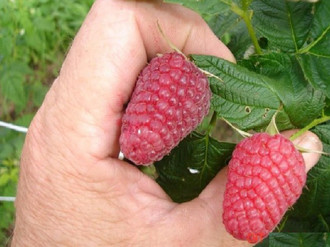 9.5 / 10 Rating Reviews The best raspberry variety for Siberia, for fresh consumption. I have 2 bushes planted especially for children. The overgrowth does not torment, I also don’t fiddle with shelter.
|
|
Yellow giant 300 (for one year old seedling in a bag with wet moss) A classic variety of early ripening yellow raspberries. The bush is powerful, 2 - 2.3 m high. 8 - 10 replacement shoots are formed, but the bush remains compact and does not fall apart. Young shoots without thorns, on old ones - in small numbers. It is prone to strong branching of fruit branches: up to 4 - 5 orders of magnitude. Intensive development of root growth. The main fruiting is on last year's shoots, but under favorable conditions, a second wave of fruiting is possible at the tops of the young growth. Amber-yellow years broadly conical with a blunt apex, up to 4 cm long and weighing 8 - 10 g. The yield per bush exceeds 4 kg. Due to poor transportability, they are used only for personal use. In the middle lane, it shows insufficient winter hardiness and requires additional protection. Shoots are flexible and bend easily for winter shelter. Main pluses:
Minuses:
|
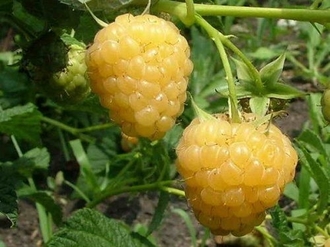 9.5 / 10 Rating Reviews I keep several bushes of this raspberry as a treat. The variety is appreciated for its excellent taste and beautiful berry. Not suitable for sale, processing and freezing.
|
|
Patricia 200 (for one year old seedling in a bag with wet moss) A classic variety of large-fruited raspberries. Sprawling bush, 1.5 - 1.8 m high, annually gives 6 - 10 replacement shoots. Forms a lot of root growth, which should be removed in a timely manner. A garter to the trellis is required. Shoots of the first year without thorns. At the end of the season, formative pruning of the shoots is required. Fruiting begins in mid-June and lasts until mid-August. The berries are bright red, cylindrical or irregular in shape, with a velvety bloom, with an average weight of 5 - 6 g (up to 10 - 12 g). Drupes are large, fit tightly. The aroma is pronounced. The average yield is 4 - 5 kg per bush, but can reach 8 kg. Berries do not tolerate transportation well and are not intended for long-term storage. The variety does not tolerate waterlogging. Recommended for the Central region of Russia, but successfully grown in the Urals. Main pluses:
Minuses:
|
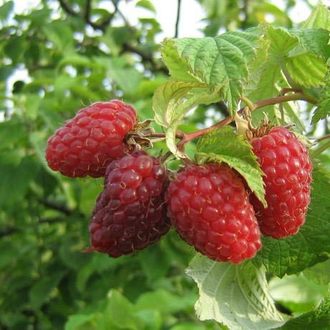 9.4 / 10 Rating Reviews Berries with a very delicate pulp, ideally: pick and eat immediately. With the harvest, raspberries cannot be postponed - overripe berries mold and crumble.
|
The best standard raspberry varieties
|
Tarusa 300 (for one year old seedling in a bag with wet moss) Standard raspberry with late ripening. In one season, a branchy tree grows up to 1.8 m high, with thick shoots on a trunk. Shoots are elastic and do not need a garter, there are no thorns. The variety branches beautifully and does not need special labor-intensive pruning. Gives 3 - 4 replacement shoots annually. No more than 10 shoots are left in the bush. Berries are burgundy-red, sweet and sour, conical or irregular, up to 10 - 15 g, dense and transportable, have a pronounced aroma and are good for processing. Small seeds are almost not felt. Productivity is high: up to 4 kg per bush. Despite the high declared winter hardiness, freezing is observed in the windy area in snowless winters. Grown from the Moscow region to the Urals. In rainy summers, the berries are watery and sour. The taste is strongly influenced by grooming and feeding. Main pluses:
Minuses:
|
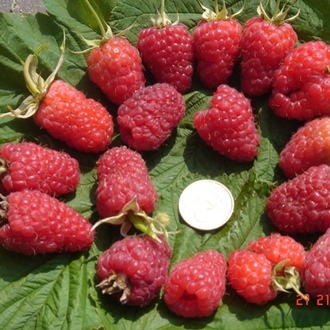 9.7 / 10 Rating Reviews The shoots at Tarusa are powerful, but under the weight of the crop they still sag and can break, so I use a trellis. Good yield, we use it for making jam and jam - it turns out very fragrant.
|
|
Monomakh's hat 270 (for a one year old seedling with a bag of wet moss) Standard raspberry variety with remontant fruiting. The bush is up to 1.5 m high, forms up to 5 powerful branched shoots with drooping tops. The lower part of the shoots has hard thorns. Due to the weak formation of shoots, cuttings are more often used for reproduction. Berries of juicy red color, weighing from 7 to 20 g, pyramidal with a blunt top, sweet with a slight sourness and bright aroma, leveled and mouth-watering. When assembled, they do not fall apart, are suitable for storage and transportation. An average of 4 - 5 kg is harvested from one bush. Reacts painfully to interruptions in watering, tying small berries. The variety has an average winter hardiness. In the northern regions, under conditions of early frosts due to late ripening and extended fruiting, it realizes only 50% of the potential yield. This raspberry variety is good for the southern regions. In the middle lane, it is grown in an annual crop, when in autumn the shoots are cut to ground level. Main pluses:
Minuses:
|
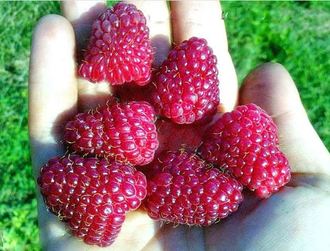 9.3 / 10 Rating Reviews Dessert-tasting berries, neat, fruitful bushes. Raspberries require attention, but this is for all large-fruited varieties.
|
Studying the varietal diversity in the catalogs of online stores or nurseries, one should not forget about acclimatization and varietal testing in new climatic conditions for the variety. If the raspberry variety seems attractive to you and has positive reviews in other regions, then first you should buy 1 - 2 bushes, provide them with better conditions and conduct your own assessment. The taste, the strength of growth, the ripening period are largely determined by the growing conditions: the climatic zone and agricultural technology.
Have a nice harvest!
Attention! The reliability of the information and the results of the ratings is subjective and does not constitute advertising.

Raspberries are rightfully considered one of the most popular horticultural crops among gardeners in different countries. Some prefer traditional varieties, others choose remontant raspberries. The difference between one variety and another is that in the second case it is possible to harvest a bountiful harvest twice a year - first in the summer on last year's shoots, then in the fall on new shoots that have grown over the summer.
Previously, the possibility of growing such raspberries was available only in warm regions, but not so long ago, Russian breeders bred a raspberry variety with a short growing season. This type of remontant raspberry is suitable for cultivation even in the northern regions of Russia.
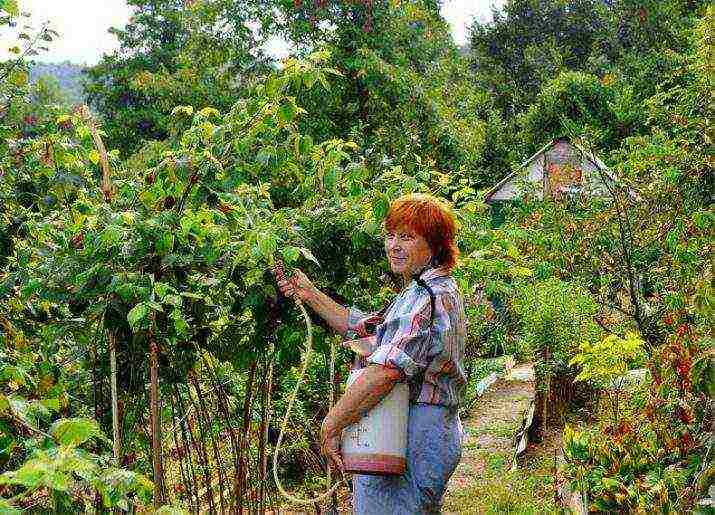 Peculiarities
Peculiarities
Recently, the cultivation of a remontant variety has been very popular among Russian gardeners. Some, on the contrary, try to grow traditional varieties, as they fear that the second crop will not have time to ripen due to early frosts.
Repaired raspberries are distinguished by their unpretentiousness, high fertility and resistance to diseases and pests. She can bear fruit in the first year after planting. Also, these varieties have an extended fruiting period and bring two harvests per season. In the first year after planting, subject to proper care during the season, the first crop can be harvested in August or September of this year.
Raspberries will give the next fruits in the middle of June next year. But it should be borne in mind that the quality of berries on two-year-old stems is somewhat worse than on annual ones. Fruits grown on second year stems are rather soft, too dry and have a lot of seeds. Also, the first harvest of raspberries in the summer can significantly delay the second harvest, the autumn. This is due to the fact that the plant spends a lot of energy on the formation of annual shoots and stems necessary for future harvests.

In order to protect themselves, summer residents often plant several varieties of raspberries on their site at once. By planting early, middle and late remontant varieties of raspberries, you can get many times more harvest and provide yourself with tasty and healthy berries for the whole year.
Which one to choose?
Repaired raspberries differ in terms of fruit ripening. When making a choice in favor of a particular variety, one should take into account the climatic zone of the plant's growth.
In addition, the varieties are distinguished among themselves by the ripening time. There are three types of remontant raspberries in terms of ripening: early ripening, mid-ripening, late-ripening.
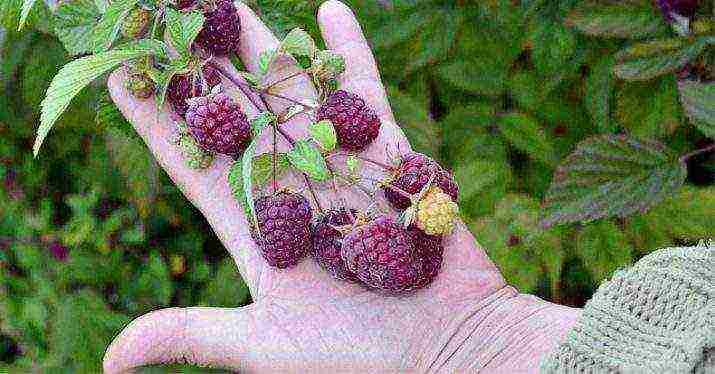
Early ripe raspberries bear fruit in early summer or late spring. The ripening period lasts until the first frost. Since these varieties are frost-resistant, they are well suited for cultivation in the northern regions of Russia with a cold climate. The best varieties of early ripening remontant raspberries are such varieties as:
- "Hercules" Is a prolific variety with large berries. The plant is extremely resistant to harmful microorganisms and adverse environmental conditions. The height of the bush can reach two meters. The main advantages of this variety include quite simple care, good transportability and excellent taste. One bush "Hercules" gives up to 2.5 kg of berries.

- "Bryansk Marvel" - the height of the bush reaches 1.5 meters. The fruiting shoot zone is 2/3 of the total plant height. The fruits of this variety are rather large, weighing up to 11 grams and about 4 cm long. The berries have a sweet and sour taste and a beautiful and even appearance. Plants are resistant to drought and high temperatures, and are also well transportable. Ripening of berries begins in mid-August and ends with the onset of late frosts. With proper plant care, one raspberry bush can yield about 3-4 kg of berries.
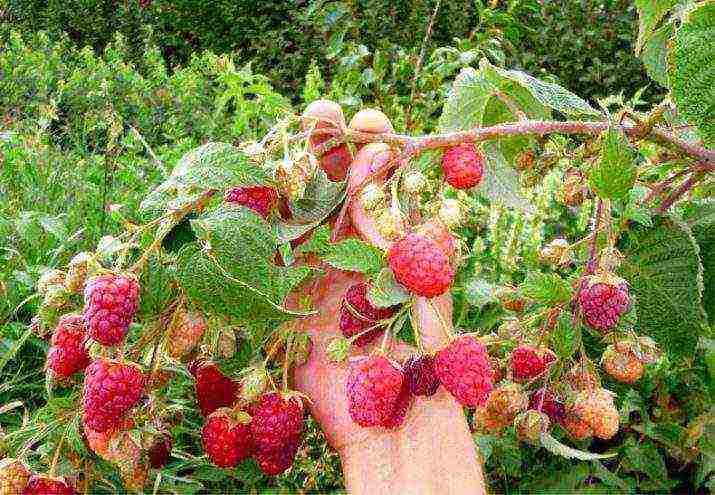
- "Diamond" - a raspberry bush with large berries weighing about 6 g, which are distinguished by their bright taste and unusual color. The stems of the plant do not have thorns, which allows you to quickly and painlessly harvest. The height of the stems is up to 140 cm. At a temperature of +5 degrees Celsius, the berries can be stored for a long time. The main advantage of this variety is that there is no need to pick the berries every day as they ripen.Ripe berries without changes can remain on the stems for a week. One bush brings on average 3-8 kg of berries.
- "Red Guard" - the variety is very popular due to the huge size of its berries. Shoots reach a height of 1.6 meters. Half of the height is fruitful. The berries of this variety are delicious and sweet. Each berry weighs approximately 6 grams. The bush yields a maximum of 3 kg of such berries.

- "Bryansk Jubilee" is a small shrub with little branching. With proper plant care, the first fruits appear at the end of July. The berries of this variety are medium in size. They have a deep red color, sweet and sour taste and an elongated shape. The yield of these bushes is quite high. The main thing is to feed and water the plant in a timely manner. Some diseases of the "Bryansk Jubilee" are not terrible.
All of the above varieties are adapted for growing them in regions of Russia with unfavorable climatic conditions.
Mid-season varieties of remontant raspberries begin to bear fruit towards the end of August. The ripening period lasts until the first frost, so they are suitable for growing in central Russia. Examples of the most suitable varieties of mid-season raspberries for growing in the Moscow region and other regions of central Russia:
- "Ruby necklace" - the plant is a medium-sized bush with few stems. The berries are in the shape of a cylinder, painted in a bright ruby color. The taste of the fruit is sweet and sour. The variety is quite fruitful, about 2.5 kg of tasty and large berries can be harvested from one bush per season. Fruit weight is approximately 8 grams. The ruby necklace has good transportability, which is why it is often used for industrial and commercial cultivation. After harvesting from the shoots, they must be cut off. Thus, you prepare the plant for wintering.
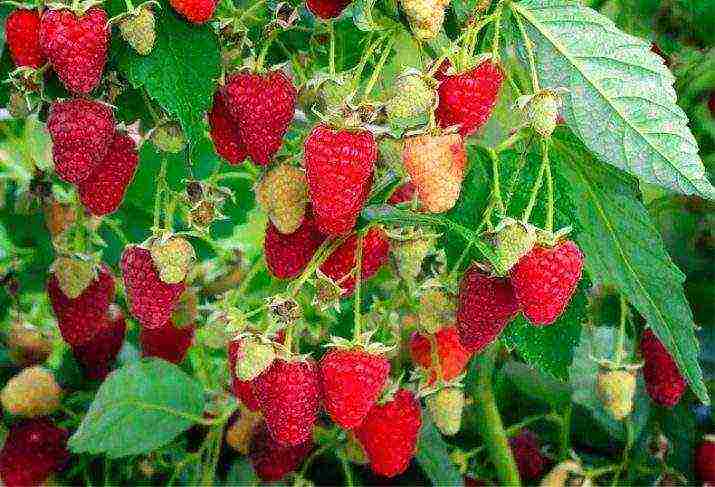
- "Orange miracle" - the variety got its name from the bright orange color of its fruits. The weight of the berry is about 12 g, and the length is 4 cm. Excellent taste of the fruit. The shoots of the plant are not tall, and the shape of the berries is elongated. Due to its high yield and large fruit size, the variety is very popular among gardeners.
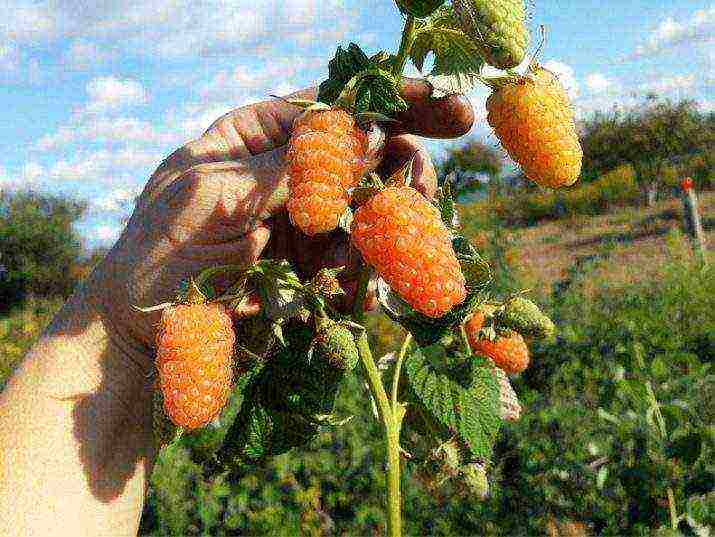
- "Polyana" - the variety is a small bushes with an average productivity. Berries are small in size and weigh no more than 4 grams. The berries grow on branches close to each other. The fruitful shoot area is approximately one meter. Gardeners are attracted to this variety by the fact that it is particularly resistant to harmful insects and fungal diseases.

- Atlant - a variety characterized by rather large, regular-shaped berries, elongated at the end. The weight of one berry is about 11 g. The variety is characterized by good transportability, resistance to various diseases and good appearance.

- "Indian summer" - the bush is capable of reaching a height of 1.8 meters. The shoots are rather sprawling. The productivity of this variety is small. On average, about 1 kg of berries can be harvested from a bush per season. At the same time, the size of the berries is small. The shape of the berries is spherical or round-conical. The color of ripe fruits is dark crimson. Many people love "Indian Summer" for its sweet taste, unpretentious care, high resistance to many pests and diseases, such as spider mites and powdery mildew. Also, the plant tolerates winter well and does not require additional shelter.
"Indian Summer" is the first variety bred in Russia. It is suitable for growing in central and southern Russia.
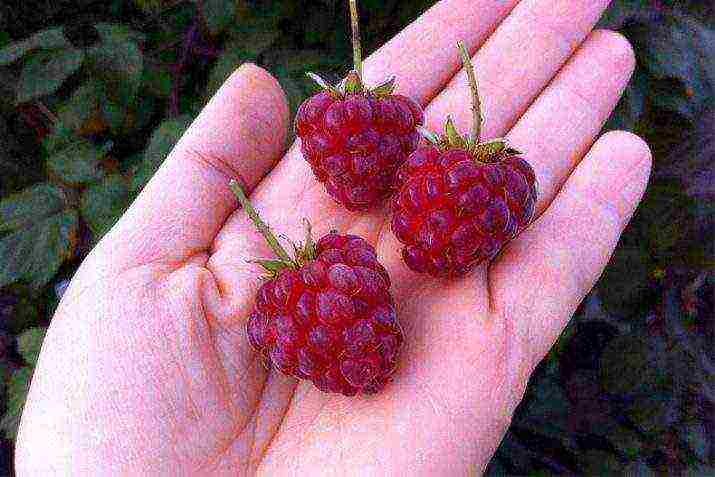
Repaired raspberries are also late ripening. These varieties are:
- "Cumberland" - has shoots of medium height with a large number of thorns. Berries are black, small in size, very sweet in taste.It is characterized by simultaneous ripening, cold-resistant, and also tolerates drought, temperature changes and various diseases, including those associated with parasites.
- "Heritage" - is a bushes with large and tall shoots. The berries are bright red, medium in size. It has a high yield, tolerates diseases well, but suffers from a sharp cold snap and high humidity.
In addition to all of the above varieties of remontant raspberries, there are those that are even more productive. These varieties include:
- Brusvyana - this is an early ripe raspberry. It is a tree-like shrub with strong shoots that do not need garters. Its height can reach two meters. Average productivity during the season is 8 kg. In addition, Brusvyana is distinguished by excellent taste.
- "Yaroslavna" - this variety is a yellow berry. The berries and the appearance of the bush are very similar to Brusvyana, but are smaller in size. On condition of correct and timely care "Yaroslavna" will be able to produce the same large amount of fruits.
- "Polka" It is a small, medium-sized shrub with many lateral stems. Polka has a long fruiting period. The advantage that many gardeners give preference to it is the absence of thorns on the shoots. The berries have a neat appearance and a sweet, but not sugary taste. Due to its taste, Polka is called the standard. Although this variety is not the most productive, on average, it can be harvested about 3.5 kg, however, it is highly respected for its excellent transportable properties.
- "Penguin" - is a bush with a height of 1.3 meters. The variety is the most productive. With proper care, one bush bears up to 15 kg of fruit. The first crop is harvested at the end of May, the second ripens by the end of August. The variety differs in pink berries of about 7 grams each with small seeds. They taste sweet and sour. Due to the small growth of the bush, there is no need for a garter and support of the shoots.
- "Shugana" - a variety originally from Switzerland. On average, 9 kg of berries are removed from the bush. The berries are quite large and have excellent taste characteristics.
- "Apricot" - an exotic variety. It is a small but rather prolific bush. The average berry weight is 3-4 grams. The berries are small, but the bush is completely covered with them. Fruits are yellow with a pink tint. Sometimes the color of the berries can be rich amber. The taste is reminiscent of the taste of apricot, thanks to this, and such a name. The yield of this variety can last until mid-October.
- "Yellow giant" - this is the most representative variety among remontant raspberries in terms of the amount of harvest. The berries on the shoots are very large, weighing about 12 grams. One bush brings about 12-15 kg, if you follow all the rules for caring for the plant. The quality and taste of the berries are excellent. Also, the "yellow giant" is distinguished by its special cold resistance and yield stability.
Among the popular varieties, one can distinguish such as:
- Polana;
- "Taganka";
- "Eurasia";
- "Nugget";
- "Imara";
- "Caramel".
They have mostly only positive reviews. But it is necessary to look whether they are suitable for the north - for example, the Leningrad region, Siberia or the Kuban.
How to match for different regions?
Russia is the world leader in raspberry cultivation. The temperate and cold climate of our country is ideal for breeding and growing this berry. But you need to carefully select one or another variety that is suitable for growing in your region. Attention should be paid to frost resistance, heat and drought tolerance, and how the plant tolerates winter.
Some varieties of raspberries do not tolerate frost and require additional shelter for the winter in regions such as the Moscow region, the Urals and other central regions of Russia. There are pros and cons when growing raspberries in different areas.
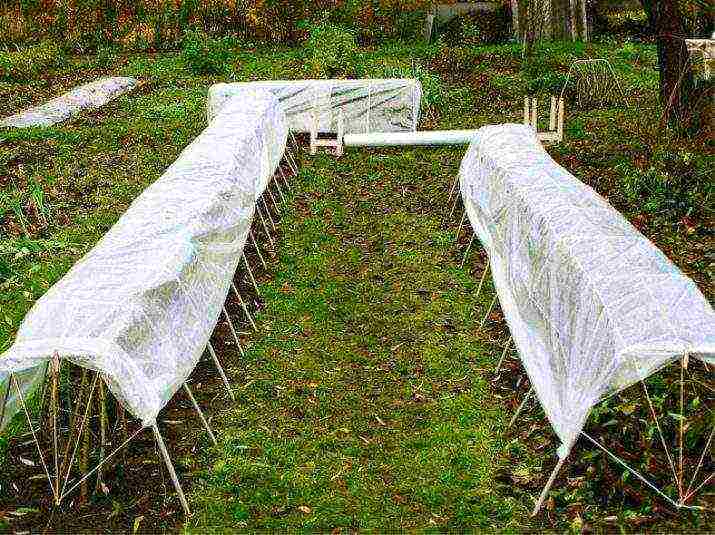
In most of our country, summer is short, and two raspberry crops often do not have time to ripen. But for the middle zone and northern corners of Russia, benefits were also found for growing this berry variety. Experienced gardeners try to prune old shoots, thus allowing the plant to gain strength faster and grow new young and more fruitful shoots. Thus, abandoning the first harvest, they receive one, but richer and more abundant harvest at the end of summer, and in the second year of cultivation - in September or October.
This does not apply to the southern regions. There are many warm and sunny days in these places, thanks to which remontant raspberries can fully justify their name and give two harvests per season.
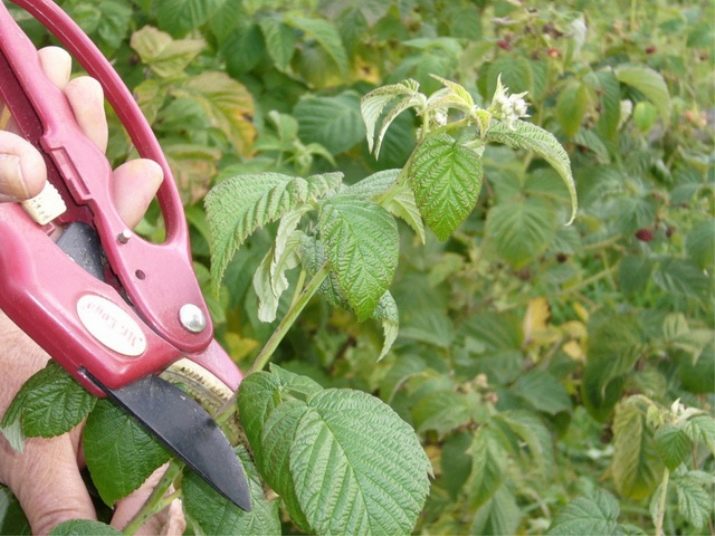
On the one hand, favorable growing conditions in the south of the country contribute to the collection of a large two-time raspberry harvest, but on the other, it should be borne in mind that raspberries come from northern latitudes, so they are more frost-resistant than drought-resistant.
Raspberries easily tolerate low temperatures, long spring and cool summer for her is the best option. It often grows best in cooler climates, so it is important to choose the right variety for growing in warm or temperate latitudes.
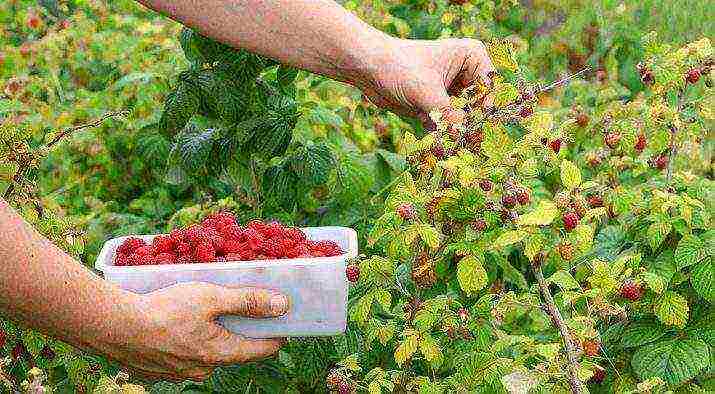
It has been scientifically proven that the problem of growing remontant raspberries in the southern regions is the drying of plant shoots in summer, as well as their exposure to snow from the wind in winter.
For the successful growth and ripening of raspberries, you need:
- protect shoots from the wind;
- residual moisture in the soil;
- it is advisable to avoid direct sunlight. It is better that the area where the raspberries grow is shaded.
Remember, raspberries are not the most whimsical plant, and it can grow both in the south and in the north, but you should choose the varieties that are suitable for your particular region, and correctly determine the place for planting on your site. Raspberries grow everywhere, but they require different care depending on the climate, therefore, they give a different harvest volume.
Tips from experienced gardeners
Spring care and preparation for winter outdoors should be done with utmost care. The scheme and correct technology of work on a personal plot will help to grow a good harvest.
Every gardener wants his plants to produce the highest possible yield. Remaining raspberry varieties, as shown by the characteristics described above, will yield much greater results than conventional varieties. The “Yellow Giant” variety is the benchmark for all varieties in terms of quality and quantity. No other variety of remontant raspberries can boast of such yield indicators.
When choosing one or another variety of raspberries, it is necessary to take into account the conditions of their growth. Each variety has its own zone suitable for climatic conditions. And in order to get a good result at the end of the season, you should take good care of the plants in a timely manner. Poor care can also cause disease and death of the plant.
Before planting raspberries on the ground, you need to choose the best place for this. An excellent place will be the south side of the site with high-quality and loose land. It is best to avoid areas that are too shaded in the northern regions, as sun is needed for fruit to ripen well.
The best time of the year for planting is autumn, if necessary, you can do this in summer. The main thing is to observe the terms, the depth of planting of the seedling and the density of the planted plants.
According to the timing, it is recommended to plant remontant raspberry bushes at least a week before the first frost. The established raspberries are capable of producing crops even with slight frosts, but it is imperative that the young plant be planted before the cold snap.
Many gardeners practice planting raspberries when it gets warm and often gives even better results than planting in the fall.But not all seedlings will have time to gain enough strength, reach maturity and give out a good harvest. A bountiful harvest can be obtained only in the second year after planting.
As a rule, the bushes of remontant raspberries reach a height of 2.5 meters, the stems are thick and strong, and the root system is bunched. Because of this arrangement, the plant receives nutrients only from the depth at which the lateral roots are located. Therefore, the maximum planting depth of remontant raspberries is 30-50 cm. This will allow the plant to freely receive nutrients and minerals.
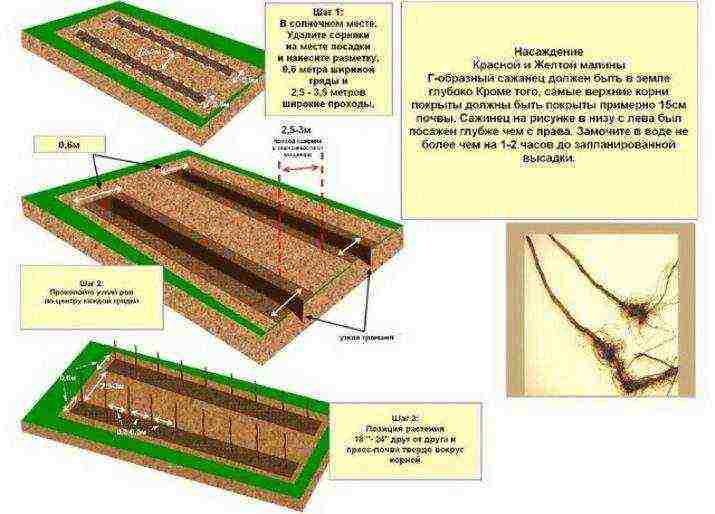
When determining the density of planting, when planting one or another variety of remontant raspberries, you should pay attention to the thickness and height of the stems. You should not plant plants close to each other (no more than one bush per one running meter), so that this does not interfere with their successful growth, as well as caring for them.
It is also necessary to pay due attention to the fertilizer for raspberries. When planting on the bottom of a pre-dug hole, add compost at the rate of two buckets per running meter or humus and potash fertilizers. Fertilizers can be replaced with wood ash.
The pit should be filled up observing the layers:
- selected fertilizers;
- fertilized soil;
- a layer of fertile land.
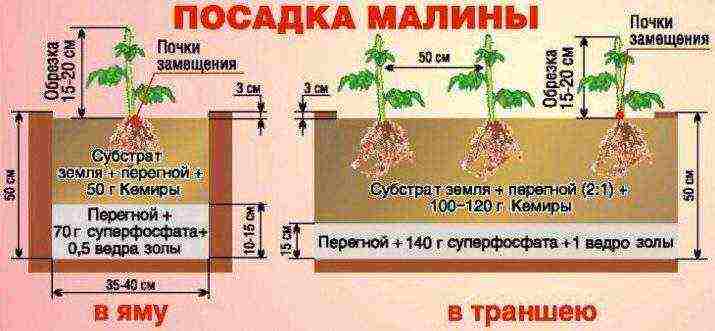
To obtain a good result, it is also necessary to prune the bushes in a timely manner. If there are early-maturing raspberry varieties in the garden, then biennial plants should be pruned after the harvest is harvested. This can usually be done in late autumn. To get a good harvest in summer, you should prune the shoots to ground level. To trim correctly, you should adhere to the following rule:
- cut off shoots every year 2 times;
- the best time for circumcision is November or December and April;
- do not cut the tops of the plant, since fertilization takes place here - this is one of the most basic mistakes of gardeners, which does not give them the opportunity to get a rich harvest;
- pruning is needed in order to delay the harvest.
It is important to prune remontant raspberries regularly in the spring to get a proper harvest. It is necessary to remove areas frozen and dried up during the winter at a distance of 10-15 cm from the first bud on the stem. Such pruning is done in April, when the first buds begin to appear, and the dead sections of the stem become clearly visible.
For information on how to grow remontant raspberries, see the next video.
For more than 200 years in Europe and America, a crop such as remontant raspberry has been cultivated. But in Russia, still relatively recently, it was known only to a narrow circle of specialists, since the climatic conditions of our country did not allow harvesting a tangible harvest of berries - they did not ripen before the onset of frost. But the works of the outstanding scientist I.V. Kazakov created varieties adapted to our realities, and now any gardener can grow such raspberries in his own area. There are plenty to choose from.
Benefits of remontant varieties of raspberries
The popularity of remontant raspberries is due to three main factors:
- Ripening of berries in late summer and early autumn, when the classic varieties of raspberries are already leaving.
- Raspberries are practically not affected by pests, because their development cycle is adjusted to the classic varieties.
- Growing raspberries in a one-year cycle eliminates the problem of wintering shoots.
It is difficult to choose the best from a wide variety of varieties, take as a basis varieties from the State Register of Plants and several popular foreign ones.
Indian summer
The firstborn of the remontant varieties of I.V. Kazakov, included in the State Register of Plants in 1995 for the Central, North-West and North-Caucasian regions. The beginning of raspberry ripening is the second decade of August. Shoots are low (up to 1.5 m), slightly spreading with large thorns. During the season, 10-15 shoots appear per meter. Medium-sized red conical berries (weight 2.1-3.0 g), yield 1 kg per bush. The taste is good, the tasting score is 4.5 points.
Indian Summer Plantation, video
The variety is resistant to gray rot and curl, but can be affected by powdery mildew, purple spot and spider mites.
Bryansk miracle
The name indicates the origin of remontant varieties of raspberries I. V. Kazakova: Bryansk region. The ripening period is late, the shoots are tall, but slightly spreading due to their thickness. The average weight of the berry is 4.3 g. The color of the berry is light red, shiny. The sweet-sour and aromatic pulp has a taste of 4 points.
Maturation of the Bryansk diva, video
Standard resistance to diseases and pests.
Brusvyan
A variety bred by Ukrainian breeders in the nursery of the same name. Very powerful shoots (2–2.5 m) and 1.5 cm in diameter at the base. The beginning of raspberry ripening in the one-year growing cycle is the first half of August, the end usually falls on October. The berry is large, 10–12 g, and 2.2–2.5 kg can be harvested from the bush. On the shoots of the second year, the berry ripens in June, but not so large. Dense and juicy red pulp with a real raspberry flavor, tasting score from 3.9 to 4.3 points. Good keeping quality and transportability.
Brusvyana, summer fruiting, video
The variety has high heat resistance, but also a high demand for watering.
Hercules
One of the most common varieties, despite the fact that only Central is officially the region of admission. Shoots are upright, slightly spreading with hard thorns. Raspberries begin to ripen in the first half of August and fruiting lasts until frost. Red conical berries with an average weight of 6.8 g of sweet and sour taste, aromatic. Tasting score 4 points.
The exploits of Hercules in the Vologda region, video
Hercules is weakly affected by diseases and pests, unpretentious in care.
Eurasia
The name of the variety directly indicates its zoning: throughout Russia. The bush is of the standard type, medium-sized, the shoot-forming ability is medium. The ripening period is from the third decade of June to mid-September, raspberries have time to almost completely give up the entire harvest. Conical berry of dark raspberry color without aroma, sweet and sour. The berry mass is 3.6–4.6 g. The tasters' assessment is 3.9 points.
I liked the Eurasia variety, video
Resistance to diseases and pests is average. High drought tolerance.
Golden domes
The variety is zoned for the Central region. The bush is medium-sized, medium-spreading. The berry is hemispherical, with an average weight of 3.8 g, yellow in color. Overripe berries become apricot color. The pulp is tender, sweet and sour. There is no tasting score in the State Register, but, according to some sources, it is 4 points. This variety is usually grown in a two-year cycle, then the first harvest on two-year shoots begins at the junction of June-July, and the second wave of harvest (from annual shoots) begins in August and lasts until frost.
Delicious raspberry Golden domes, video
The variety is resistant to diseases and pests, self-fertile.
Zyugana (Shugana)
A modern Swiss variety of large tasty raspberries. The berry is red, with a noticeable shine, with an average weight of 5.4 g. The bush is of a half-stem type, powerful and can do without a garter, there are no thorns. The yield is high, up to 8-9 kg per bush. Tasting score 4.5 points.
Zyugan in Belarus, video
Breeders of Zyugana declare its high frost resistance and complex resistance to the main diseases of raspberries. In Europe, the variety is grown for two harvests: in June and August. In Russian conditions, both this method and harvesting only from annual shoots are possible.
Orange miracle
Another variety of yellow remontant raspberries, but already zoned for all regions of the country. Ripening period is average, it starts from the end of July and ends with the first serious frosts. The bush is high, medium spreading, the shoot-forming ability is high. The berry weighs an average of 5.5 g, the color is bright orange, the shape is blunt-conical. Dessert taste, tasting score 4 points.Transportability is below average.
Delicious Orange Wonder Video
Disease and pest resistance is standard, medium drought resistance and heat tolerance.
Penguin
Raspberry bush of standard type, low, straight. The variety is approved for cultivation in all regions. Average shoot-forming ability (4-6 shoots per bush). Thorniness is medium, high at the bottom of the shoot. The berry is large, with an average weight of 4.2 g, dark raspberry color. The taste of the pulp is sweet and sour, without aroma. Tasting score 3.7 points.
Penguin in October, video
Medium heat and drought resistance. Average resistance to diseases and pests.
Bow to Kazakov
A modern variety of remontant raspberries, recommended for cultivation in all regions. Medium ripening. The bush is powerful, semi-spreading. Great shoot-forming ability. Shoot thorns are small. Berry with an average weight of 3.7 g, dark red, shiny. The taste is sweet and sour, with aroma, the assessment of tasters is 4.3 points.
Raspberry bush Bow to Kazakov, video
Standard disease and pest resistance, drought and heat resistance are average.
Polana
An unpretentious variety of Polish raspberries. Grown in the Central region of Russia, South-West, southern regions of the Urals and Siberia. The bush is not high, 1.5–1.8 m, giving 5–8 replacement shoots annually. The beginning of ripening of berries from mid-August to the onset of frost -2 degrees. The thorns are inconspicuous. The average berry weight is 5 g, the yield per bush is 4–5 kg. The berries are round, red, shiny. Sweet and sour taste, tasting score 4.1 points.
Autumn fruiting Polana, video
Drought resistance and heat tolerance are average, high frost resistance. Resists raspberry diseases well, with the exception of wilting shoots and fruit rot. High transportability.
A shelf
Also a Polish variety, which in fact has become the European Union standard for remontant raspberries. The growing regions in Russia are the same as for the Polana variety. Strong, medium-sized (up to 1.8 m) shoots that do not require a garter. There are no thorns, the shoot-forming ability is high - up to 10 shoots per bush. Raspberries begin to ripen from the end of July. The berry is large, red, conical and of a stable size. Average weight 7 g, yield per bush 2 - 4 kg. Dessert taste, sweet and sour, with a strong aroma. Tasting score 5 points.
Sweet raspberry Shelf, video
Drought and frost resistance are average, heat tolerance is below average. Resistant to raspberry diseases except root cancer. Transportability is good. High requirements for agricultural technology.
Ruby necklace
The variety is zoned for all regions of Russia. Raspberry ripening begins in mid-August and lasts until frost. The bush is medium in size, up to 1.5 m high, medium spreading. The bush gives 5–8 replacement shoots annually. Thorns all over the stem, large. Berry weight 4.2-5.6 g, bright ruby color. The variety is characterized by a high yield, up to 3.5 kg per bush. Tasting score 3.8 points.
Ruby necklace, video
Standard disease and pest resistance. Average drought and heat tolerance.
Heritage
A time-tested variety of American selection, it is recommended for cultivation in the Central region of Russia. On annual shoots, the berries begin to ripen by the end of August, on two-year-olds - from June. The bush is medium spreading, high, up to 1.5–2 meters, its garter is desirable. Shoot-forming ability is moderate. The thorns are small. The average weight of a rounded-conical berry is 3.5 g. The color of ripe raspberries is maroon, sweet-sour taste, with aroma. Assessment of tasters 4.5 points. Transportability is good.
Malina Heritage in the nursery, video
The variety tolerates frosts of the middle zone well and requires intensive watering in dry years.
The best varieties of remontant raspberries, photo gallery
And what are we going to plant?
A large number of good varieties of remontant raspberries can make it difficult for a novice gardener to choose a variety for himself.
Let's try to help him by asking a few simple questions:
- For what purpose will the raspberries be planted: only for themselves or for sale too?
- Is the place of the proposed planting of raspberries limited?
- How regular will be raspberry care?
- Is the presence or absence of thorns on the stems essential?
- And, finally, in which region the gardener lives.
The final choice in favor of this or that variety depends on the answers to these questions.
Have a good presentation, transportability, productivity and a sufficient number of replacement shoots for reproduction of raspberries such varieties as Brusvyana, Zyugana, Polana, Shelf, Ruby necklace, Heritage... Growing these raspberries for sale can replenish the family budget.
Poorly stored and transportable tasty Golden domes, Orange miracle, Indian summer.
Raspberry varieties Eurasia or Penguin - low bushes of the standard type with a small shoot-forming ability. They will not take up much space and will not actively creep over the site.
Unpretentious variety in care Herculesslightly more demanding Polana... And here Shelf, Brusvyana, Zyugan, Heritage require increased attention to themselves, in particular, regular watering.
There are no thorns in varieties Zyugan and Polka, small y Bows to Kazakov, Polana and Heriteij... But at Indian summer, Hercules, Eurasia and Ruby necklace the thorns are large.
Many domestic varieties of remontant raspberries are recommended for all regions of the country with crops grown only on annual shoots. This is Bryansk miracle, Eurasia, Orange miracle, Bow to Kazakov, Ruby necklace. This also includes the variety Hercules.
Indian summer recommended for the North-West, North-Caucasian and Central regions with cultivation in both a two-year and one-year cycle.
One-year cycle - growing remontant raspberries only on one-year shoots with cutting off the entire aerial part of the plant in autumn. In a two-year cycle, only two-year shoots are cut off in autumn. Raspberry for the next year gives a harvest on the shoots of the current year and last year.
Polish varieties Shelf and Polana, Ukrainian Brusvyan more suitable for those of our regions where the climate is similar to their homeland, namely the South-West, the south of Siberia and the Urals, Central Russia. Similar requirements for climate and varieties Zyugana and Heritage, they have good frost resistance.
Very often, remontant varieties of raspberries do not have time to give up the entire crop before the onset of cold weather, and it looks good here Eurasiaending fruiting in September. She, however, has a low tasting score and an average disease resistance.
It should be noted that the varieties of yellow raspberries Orange Miracle and Golden Domes are hypoallergenic - they can easily be enjoyed by people suffering from allergic diseases.
Caring for remontant raspberries, some features
Older people, of course, remember the slogan of the past: "Five-year plan in four years!" Repaired raspberries spend only one season for the development cycle from the appearance of a "nettle" of a young shoot to a ripe berry, while a classic raspberry spends two. Therefore, it is necessary to provide the "leader" with comfortable living conditions.
Choosing a landing site
Plant raspberries in the sun, if possible near a fence that will provide them with a comfortable microclimate. In summer, due to heat radiation and air convection, and in winter, due to increased snow retention. Raspberries growing in the shade will be smaller and sourier and more likely to get sick. Do not plant raspberries after uprooted old raspberries or after nightshade crops.
Raspberries do not like acidic soil; it can be deoxidized with ash, dolomite flour, or green siderates embedded in the ground.
Weeding and loosening
Try not to allow a carpet of weeds to appear under the raspberries, they will take from the soil the nutrients that the plant needs so much for intensive development. It is noticed that on good soil under raspberries such a vicious weed like runny loves to grow. It is very difficult to fight him. When loosening, do not overdo it with depth, 5–7 cm will be enough.
Watering
The drought resistance of the variety does not mean that it does not need to be watered, especially during flowering and berry setting. There are varieties that are especially demanding for watering, for example, Brusvyana and Heritage.
Top dressing and fertilizers
Any raspberry loves organic matter, and intensive remontant varieties are doubly... Therefore, three times a season: the first time at the end of May, then two more times with an interval of a month, feed the bushes with diluted mullein, horse manure or bird droppings. 3-4 years after planting, mineral fertilizers are usually added at the same time as organic fertilizing.
Pruning
The issue of pruning remontant raspberries divided the gardeners into two camps: to cut raspberries "to zero" in the fall and grow berries in a one-year cycle, or leave annual shoots for the winter and get two harvests next season. Most are inclined to the first option, which was advocated by the creator of domestic varieties of remontant raspberries, I.V. Kazakov. The main argument is to remove the problem of shoot freezing in severe winters. And also in the fact that the shoots of the first year left in the second year weaken the one-year-old shoots of the current year. The berries become smaller and a significant part of them do not have time to ripen with the onset of cold weather. This variant of the cultivation of remontant raspberries is used mainly in regions with a warm climate.
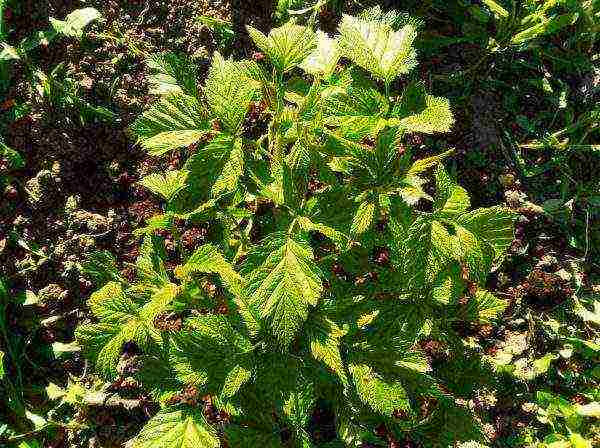
May 9, 2018. Hercules bush is actively growing
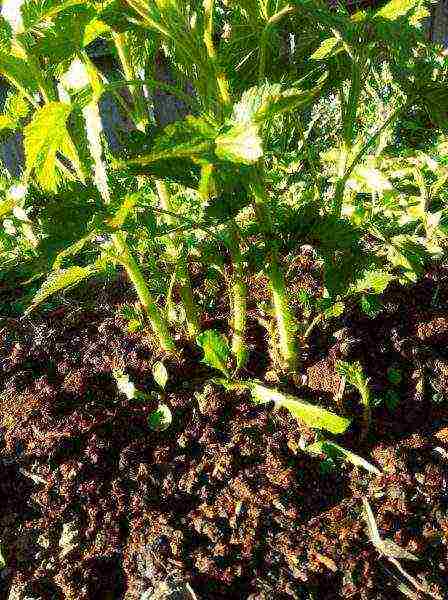
In the presence of 6 shoots of replacement
Removing berries
There is one important thing to keep in mind. Often in the description of the variety they write that a ripe berry can hang on a bush for several days without losing freshness. This, of course, is good if it is not possible to collect it. But it is better to collect raspberries immediately when ripe, then the plant directs its forces to the formation of new flower stalks and berries, and thereby increases the yield.
Reviews of gardeners who can help determine the choice of varieties
Gone are the days when raspberries were associated only with warm summer. The appearance of remontant varieties extended the raspberry abundance until late autumn. The choice for a gardener is large enough, the main thing is that the raspberry variety corresponds to the climatic conditions of the region. Also, do not forget about the more intensive development of remontant raspberries in comparison with classic varieties and provide them with proper care.
Petr Alekseevich, 69 years old, candidate of technical sciences. Rate the article:
(0 votes, average: 0 out of 5)


